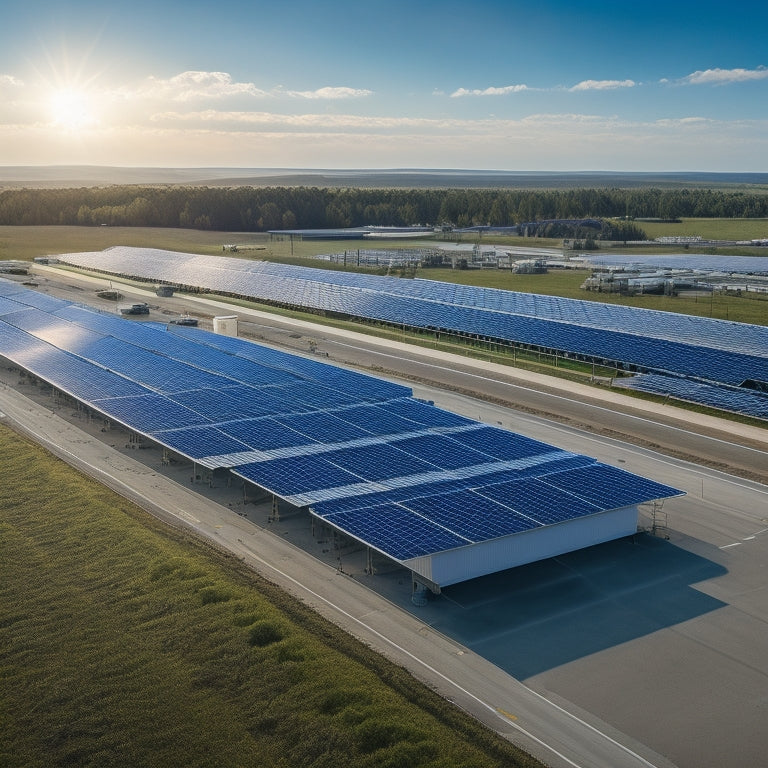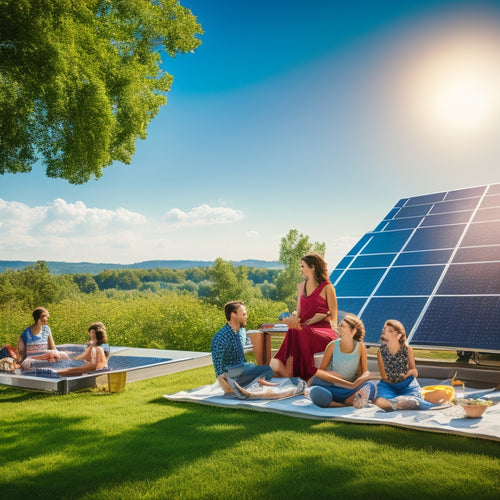
What Commercial Solar Power Solution Is Right for Your Business
Share
When exploring commercial solar power solutions, you'll want to assess your energy needs by reviewing past bills and meter readings to determine your average daily consumption and peak usage. This will help you design a solar panel system that meets your specific energy requirements. You'll then need to choose from grid-tie, off-grid, or hybrid systems, considering factors like energy goals, grid connectivity, installation, and maintenance. Your business's unique needs will dictate the best solution, whether it's a roof-mounted, ground-mounted, or carport installation. By understanding your options and evaluating costs, you can optimize your energy usage and savings – and there's more to uncover about how to make the most of commercial solar power for your business.
Key Takeaways
- Assess your business's energy needs by analyzing past bills and peak usage to determine the right solar panel system size.
- Choose from grid-tie, off-grid, or hybrid solar panel systems based on your energy goals, grid connectivity, and business requirements.
- Consider roof-mounted, ground-mounted, carport, or canopy installations, each with its own set of considerations and benefits.
- Ensure optimal energy efficiency by integrating solar power with energy-efficient upgrades and real-time energy monitoring systems.
- Evaluate the cost and ROI of different solar power solutions, including financing options, tax incentives, and energy storage solutions.
Assessing Your Energy Needs
As you consider changing to commercial solar power, evaluating your energy needs becomes a vital first step. You need to understand how much energy your business consumes and when it's needed most.
An energy consumption analysis helps you identify patterns and trends in your energy usage, providing useful observations into your operations. This analysis typically involves reviewing your past energy bills and meter readings to determine your average daily energy consumption.
A peak usage evaluation is also important in determining the maximum amount of energy your business requires at any given time. This information is significant in sizing your solar panel system to guarantee it can meet your energy demands during peak periods.
By understanding your energy needs, you can design a commercial solar power system that meets your specific requirements, reducing the risk of undersizing or oversizing your system.
Accurate energy needs assessment also helps you optimize your system's performance, maximize your energy savings, and reduce your carbon footprint.
Solar Panel System Options
You'll need to choose a solar panel system that aligns with your energy goals and grid connectivity requirements.
You have three primary options: grid-tie systems, which synchronize with the grid and provide a net metering benefit; off-grid systems, which operate independently of the grid; and hybrid systems, which combine grid-tie functionality with energy storage.
Each type of system has its advantages and disadvantages, which you'll need to evaluate carefully.
Grid-Tie Systems
Your commercial solar panel system's grid-tie configuration allows it to synchronize with the utility grid, providing a seamless and efficient way to generate and distribute electricity.
This setup enables you to take advantage of net metering benefits, where excess energy produced by your solar panels is fed back into the grid and credited to your utility bill.
Here are four key benefits of grid-tie systems:
-
Grid Reliability: With a grid-tie system, you can rely on the utility grid to provide electricity when your solar panels aren't producing enough power, ensuring a consistent supply of energy.
-
Increased Efficiency: Grid-tie systems optimize energy production by allowing your solar panels to operate at their maximum capacity, reducing energy losses and enhancing overall efficiency.
-
Reduced Energy Costs: By generating your own electricity and exporting excess energy to the grid, you can greatly reduce your energy costs and even earn credits towards your utility bill.
- Low Maintenance: Grid-tie systems are designed to be low maintenance, with fewer moving parts and no need for battery replacements, reducing your overall maintenance costs.
Off-Grid Systems
How do you guarantee a reliable source of electricity when the grid is unavailable or unstable? Off-grid systems provide a solution, allowing your business to operate independently of the grid.
This system benefits from not having to rely on the grid, assuring continuous power supply even during outages. With an off-grid system, you're not limited by grid availability or stability, making it ideal for remote locations or areas prone to frequent power outages.
When designing an off-grid system, you'll need to take into account your energy requirements and the size of the system. A larger system will provide more power, but it also increases installation challenges and costs.
You'll need to balance your energy needs with the system's capacity to guarantee a reliable supply. Off-grid systems typically include a solar panel array, charge controller, battery bank, and inverter.
The system benefits from energy independence, reduced energy costs, and a lower carbon footprint. However, installation challenges include assuring the system is designed to meet your energy needs and managing energy storage and backup solutions.
Hybrid Systems
As the need for reliable and efficient power solutions grows, hybrid systems emerge as a versatile option for businesses seeking to harness the benefits of solar energy while maintaining a connection to the grid.
By combining solar power with traditional energy sources, hybrid technology provides a reliable and efficient energy management system.
With a hybrid system, you can:
-
Optimize energy usage: Hybrid systems allow you to use solar power during the day and switch to the grid during periods of high energy demand or at night, reducing your reliance on traditional energy sources.
-
Reduce energy costs: By leveraging solar power, you can greatly lower your energy bills and lock in fixed energy rates for the life of the system.
-
Improve energy independence: Hybrid systems provide a reliable source of power, even during grid outages, ensuring your business remains operational.
- Enhance energy management: With advanced energy management systems, you can monitor and control your energy usage, making data-driven decisions to optimize your energy strategy.
Roof-Mounted Solar Solutions
When you consider roof-mounted solar solutions, you're looking at a solar panel installation that can be seamlessly integrated into your existing roof structure.
This setup enables you to capture the sun's energy while maximizing your roof's space utilization.
Solar Panel Installation
You can considerably reduce your reliance on the grid and lower your energy bills by installing roof-mounted solar solutions.
When it comes to solar panel installation, you'll want to reflect on several key factors to guarantee a successful project.
Here are 4 essential considerations for your solar panel installation:
-
Site Assessment and Installation Process: A thorough site assessment will determine the ideal placement and installation process for your solar panels, factoring in elements like roof size, orientation, and shading.
-
Solar Panel Types and Maintenance Requirements: Choose from a range of solar panel types, each with its own maintenance requirements and performance characteristics. Be sure to select panels that fit your energy needs and budget.
-
Financing Options and Incentive Programs: Investigate financing options, such as loans or power purchase agreements, and utilize incentive programs like tax credits and rebates to offset the upfront cost of your solar installation.
- Contractor Selection and Local Regulations: Carefully select a qualified contractor who's familiar with local regulations and can guarantee a smooth installation process, including obtaining necessary permits and meeting warranty requirements.
Energy Efficiency Gains
Make use of the full potential of roof-mounted solar solutions to maximize your energy efficiency gains.
By integrating solar power into your operations, you can identify areas for improvement through thorough energy audits. These audits will help you pinpoint opportunities for efficiency upgrades, allowing you to optimize your consumption patterns and reduce peak demand.
With energy monitoring systems in place, you'll have real-time visibility into your energy usage, enabling data-driven decisions that support operational sustainability.
Roof Space Utilization
Commercial buildings often possess a significant, underutilized asset: their rooftops. When evaluating a commercial solar power solution, your rooftop can be a prime location for generating clean energy. Roof-mounted solar solutions can be an effective way to utilize the power of the sun, but it's crucial to assess your roof's suitability.
Before installation, you'll need to evaluate the following factors:
-
Solar panel orientation: Confirm your roof receives sufficient sunlight and that the solar panels are installed at an ideal angle.
-
Shading analysis: Identify any shading obstructions, such as trees or adjacent buildings, that could impact energy production.
-
Roof condition: Evaluate your roof's structural integrity and condition to verify it can support the weight of the solar panels.
- Installation permits and local regulations: Obtain necessary permits and comply with local regulations, including structural assessments and maintenance considerations.
Additionally, review the aesthetic impacts of the installation and how it may affect your building's appearance.
Ground-Mounted Solar Systems
Ground-mounted solar systems, often the favored choice for large-scale commercial solar power projects, offer a high degree of flexibility and customization. As you evaluate this option, you'll need to think about land use and how you'll employ your available space.
A thorough site selection process is vital to guarantee peak system performance, considering environmental impact and potential shading issues.
When it comes to maintenance, you'll want to assess the system's orientation and potential installation challenges. Regulatory considerations will also play a role, as local authorities may have specific requirements for ground-mounted systems.
Fortunately, financing options are available to help offset the upfront costs.
To guarantee your system operates at peak performance, you'll need to invest in regular performance monitoring. This will help identify any issues and allow for prompt resolution.
With careful planning and execution, a ground-mounted solar system can provide a reliable source of renewable energy for your business.
Carport and Canopy Installations
Shaded parking areas can become a significant asset for your business with carport and canopy installations.
These structures not only provide shade but also generate clean energy, reducing your reliance on the grid and lowering your electricity bills.
When considering carport and canopy installations, keep the following factors in mind:
- Carport benefits: Increased customer satisfaction, improved employee morale, and enhanced property value.
- Structural requirements: Verify the installation meets local building codes and can support the weight of the solar panels.
- Aesthetic considerations: Choose canopy designs that complement your business's design and branding.
- Maintenance practices: Regularly inspect and clean the panels to guarantee peak energy production.
Additionally, consider the environmental impact, financing options, and regulatory compliance when investing in carport and canopy installations.
While installation challenges may arise, a well-planned project can provide a significant return on investment and contribute to a sustainable future.
Energy Storage and Backup
As your business shifts to clean energy, it's essential to reflect on how to guarantee a stable and reliable power supply. Energy storage and backup solutions play a significant role in ensuring energy resilience, especially during grid outages or peak demand periods. By integrating battery technologies into your commercial solar power system, you can store excess energy generated during the day for use during periods of high demand or at night.
| Energy Storage Solution | Benefits | Key Considerations |
|---|---|---|
| Lithium-Ion Batteries | High energy density, long lifespan | High upfront cost, thermal management |
| Lead-Acid Batteries | Cost-effective, well-established technology | Lower energy density, heavier |
| Flow Batteries | Scalable, long-duration energy storage | Higher maintenance requirements |
When selecting an energy storage solution, consider factors such as system integration, maintenance strategies, and financial incentives. Peak shaving, environmental impact, and regulatory considerations should also be taken into account. By choosing the right energy storage and backup solution, you can enhance your business's energy resilience, reduce your environmental footprint, and benefit from technology advancements in grid reliability.
Evaluating Cost and ROI
Your commercial solar power system's financial performance hinges on a thorough evaluation of its cost and return on investment (ROI). To make an informed decision, you need to take into account various factors that affect the overall cost and ROI of your system.
Here are 4 key factors to evaluate:
-
Financing options: You can investigate commercial leasing, power purchase agreements, or traditional financing methods to fund your solar power system. Each option has its pros and cons, so it's vital to choose the one that aligns with your business goals.
-
Tax incentives and long-term savings: The federal government offers tax incentives for businesses that invest in solar power. You can claim a tax credit of up to 30% of the total system cost. Additionally, you'll enjoy long-term savings on your energy bills, which can greatly impact your bottom line.
-
Maintenance costs and system warranties: Regular maintenance is essential to guarantee your system operates at its best level. Look for providers that offer extensive system warranties and maintenance contracts to minimize your costs.
- Energy audits and utility partnerships: Conducting an energy audit can help you identify areas of energy inefficiency in your business. Partnering with your utility company can also provide useful perspectives into your energy usage and help you enhance your solar power system's performance.
Frequently Asked Questions
Can I Install Solar Panels on a Leased Property?
You'll need to contemplate leased property considerations and review your tenant agreements before installing solar panels, as you'll need the landlord's permission and may require adjustments to your lease or rental terms.
How Long Does It Take to Install a Commercial Solar System?
You'll typically wait 2-6 months for a commercial solar system installation, depending on the installation timeline, which varies based on installation factors like system size, roof complexity, and local permits.
Are There Any Tax Incentives for Commercial Solar Installations?
You'll benefit from federal and state tax incentives, such as the Solar Investment Tax Credit (ITC), which can offset up to 30% of your commercial solar installation costs, making financing options more attractive and reducing your overall expenditure.
Can I Use Solar Power to Charge My Company's Electric Vehicles?
You can definitely use solar power to charge your company's electric vehicles, leveraging solar charging infrastructure to reduce emissions and operating costs, while also benefiting from potential tax incentives and rebates.
How Do I Monitor and Maintain My Commercial Solar Panel System?
You'll want to keep a watchful eye on your system's performance, so you'll need to set up a maintenance schedule to guarantee ideal energy harvesting; this includes regular inspections, cleaning, and software updates to keep your system running at peak efficiency.
Conclusion
You've got a wealth of options to utilize the power of the sun for your business, and the right commercial solar power solution is out there waiting for you. With the perfect combination of solar panel systems, mounting options, and energy storage, you can slash your energy bills and enhance your bottom line. The possibilities are endless, and the benefits are astronomical - think of it as having a money-printing machine on your roof!
Related Posts
-
Trends in Renewable Energy Storage Technologies
You're witnessing rapid advancements in renewable energy storage technologies aimed at improving efficiency and scala...
-

Solar Power Savings for Environmentally Aware Consumers
Switching to solar power lets you drastically cut your carbon footprint while saving money in the long run. Each kilo...
-

Innovative Sustainable Materials for Energy-Efficient Homes
Innovative sustainable materials enable you to create energy-efficient homes while promoting environmental responsibi...

